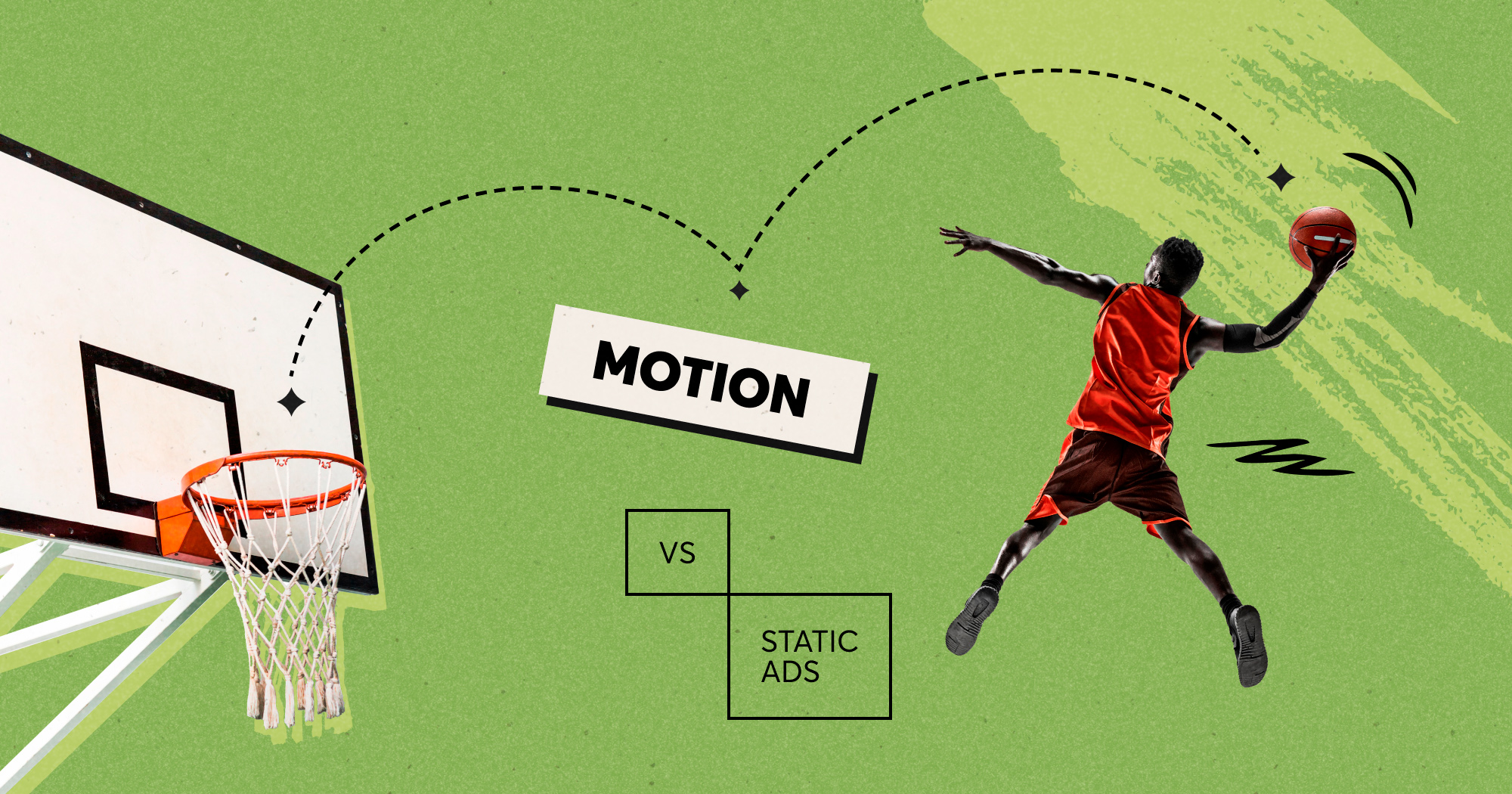While static ads have been the go-to ad format for over a decade, there seems to be growing interest in advertisement formats that are anything but static. The impact that video ads have on conversion rates and campaigns is substantial, and there’s no point in clinging on to the past. Newer, catchier ad formats are all the rage in the advertising world, and keeping up with the latest trends is the best way to give your ad campaign a competitive edge.
However, regular video ads aren’t exactly accessible for all brands. Producing a high-quality video ad is a costly and time-consuming process, and depending on what you’re trying to achieve, it can be quite limiting.
The same cannot be said about motion ads. They’re the perfect middle ground between less than captivating static ads and expensive video ads. If you are looking for a way to boost your campaign performance without overspending, then motion is your ticket to success.
Starting With the Basics: What Are Static Ads?
Feel free to skip this section if you are familiar with classic static advertising and its pros and cons. However, if you want to be fully knowledgeable in the subject of creating successful advertising, never neglect the basics.
Static ads are fixed and unchanged, presenting the same content to all viewers. They are usually created with a set design and do not contain dynamic or interactive elements. Static ads usually consist of static images, text, logos and basic design elements.
The distinguishing feature of static ads is that they do not have the ability to personalize or dynamically change their content. They provide a consistent message to all viewers. Accordingly, static advertising can be effective in directly conveying a particular message or building brand awareness. They are often used when the main goal is to deliver a clear and concise message without the need for interactive or personalized elements.
Pros and Cons of Static Ads
Simple and straightforward, static advertising has its advantages:
- Simplicity. Static advertising is easy to create and implement, requiring less time and resources than other types of ads.
- Profitability. Static advertising is often more cost-effective, making it affordable for companies with limited advertising budgets.
- Consistency. Static advertising delivers a consistent message to all viewers, providing the same brand experience for everyone.
However, the use of a single, unchanging form is not always advantageous: there are also disadvantages.
- Limited engagement. Static advertising lacks interactive elements, which limits the level of attention and interest of the user.
- Lack of personalization. Static advertising cannot be customized based on user preferences or real-time data, which may result in less targeted ads.
- Reduced visual impact. Static advertising devoid of moving or dynamic elements may have less visual impact than more dynamic and engaging ad formats.
What Are Motion Ads?
Motion ads, also known as animated ads or rich media ads, are ad formats that incorporate movement or animated elements. Unlike static ads, motion graphics ads use visual effects, transitions and animation to capture the viewer's attention and convey the advertising message. These ads can include rotating images, sliding text, fading effects or interactive elements.
As the epitome of animation in advertisement, motion advertising offers a more dynamic and engaging experience for viewers. It succeeds much better in capturing the user's attention and is much more memorable than static ads. You can read more about all motion ad specs, compliance rules and where to find animated designs for your motion ads in our Motion Ads Tutorial.
Pros and Cons of Motion Ads
In comparing static and motion ads, the latter has many obvious advantages.
- Increased engagement. Motion and animation elements can create a sense of interactivity, leading to a higher level of engagement.
- Enhanced brand awareness. Using animation in ads can help brands stand out and make a lasting impression on viewers.
- Improved message delivery. Motion ads provide an opportunity to convey complex or long messages in a concise and visually appealing way.
It would seem that there would be no disadvantages, given that motion ads are so attractive. However, there are some disadvantages to consider.
- Increased file size and download time. Motion ads often require larger files due to the inclusion of animation and rich media, which may result in slower downloads.
- The potential for intrusiveness. While motion ads are meant to grab attention, they can also become intrusive if not executed carefully.
- Compatibility and display restrictions. Not all advertising platforms, websites or devices can optimally support or display ads that include animation.
Why Motion Works Better Than Static Imagery
Our brains are calibrated in ways we don’t yet fully understand, but we do recognize the similarities and patterns in how humans register and process information. One common behavior found is a tendency to register motion far more intently and keenly than static objects or characters.
What’s probably a basic survival instinct is all the leverage that modern digital advertising needs to achieve more conversions from each ad campaign. Have no doubt about it — the data is in, and it undoubtedly suggests that motion ads are the superior format.
However, our aptitude for noticing movement is not the only reason why we love motion ads. Motion ads allow us to pack more information — telling entire stories and looking good while doing it — into the same amount of space that a static image would take up. Why not think economically and use the limited space available more optimally?
There’s also something that’s inherently soothing about motion ads. Of course, it depends on the design of the ad creative, but animation tends to calm us and give us a sense of security and familiarity. If there’s anything that brands are after, it’s comfort and familiarity.
Beyond these slightly more complex — and in some cases, psychological — reasons, motion ads are both time and cost effective. With a proper skillset and some tools, animating gifs is only a bit more demanding than coming up with unique and outstanding static ad creatives. As you’d expect, it’s also far more convenient and flexible than shooting actual videos with live actors, a film crew and all the other personnel required for such an undertaking.
Here’s How You Can Use Motion Ads to Your Advantage
There’s so much that can be done to captivate your audience’s severely limited attention spans with motion ads that it can be difficult to choose a place to start. Below, we have listed the many forms that motion ads can take to help you with a jumping off point.
Probably the most obvious use of motion ads is to demonstrate what a product or a service could do, or as Facebook would put it, demo in motion. Showing what a product looks like on a person or how it’s used is the perfect place to start your journey through motion ads.

Stop motion animation was old news, until it found a new life in digital advertising. Brands have found a way to leverage stop motion animation to tell entire stories and get their audiences engaged. It’s a quirky and fairly underused method of advertising, so well worth a shot.

Similarly, kinetic or animated typography is a perfect way to send a message or persuade users to take action. It’s one of the best ways to integrate a call to action in your motion ad.

The possibilities are limitless when it comes to incorporating special effects and motion ads. Take it from anyone who’s ever used a video editor. Naturally, you don’t want to go overboard with zoom-ins and fade-aways, but these effects are sure to make your next motion ad interesting and unique.

Likewise, looped videos are always fun to watch and an excellent way to get your audience to watch your ad on repeat without even knowing it.

Few animations feel more unique and well-thought-out than cinemagraphs. If you want an ad where only one portion of it is in motion while the rest is static, then your options are boundless. Cinemagraphs allow you to integrate motion ads in an unobtrusive manner that’s reminiscent of the static ad days.

Last but not least, cartoon or cutout ads are perhaps the most soothing and relaxing motion ads. Using ads such as these, you’re likely to put your audience’s minds at ease and have them experience your brand in a more positive and benevolent light.

Motion Ads vs Static Ads: Which Is Better?
If motion advertising is so versatile and effective, then why hasn't it pushed static ads out of the market yet? Well, while motion advertising does offer versatility and effectiveness, static ads still have their place in the market. They are often favored for conveying straightforward information or delivering a specific call to action. In addition, static ads are compatible with a wide range of platforms and devices, including older devices or slower internet connections.
As with any other advertisement, the effectiveness of static ads vs motion ads depends on a variety of factors, including the specific objectives of the ad campaign, the target audience and the context in which the ad is displayed. We have already considered the pros and cons of these types of advertising and can draw the following conclusion.
- Motion ads are particularly useful for storytelling and communicating specific points, features or benefits of a product or service.
- Static ads are best used when you need to deliver a fixed, concise message covering the maximum number of platforms, regardless of the bandwidth or speed of internet connections.
In some cases, a combination of motion and static advertising can be used strategically. For example, static ads can be used as an initial impression to convey a clear message, while motion ads can be used to retarget or reinforce a brand's message with more compelling visuals.
Final Thoughts
There’s no doubt as to whether motion ads are the better option nowadays. The only questions you have to ask yourself are how willing are you to get creative and which approach should you take.
It’s a conversation worth having with your team in order to find a medium that best conveys your core values to your target audience. After all, there’s no boosting your campaign performance without familiarizing your brand with the people you’re hoping to reach.





